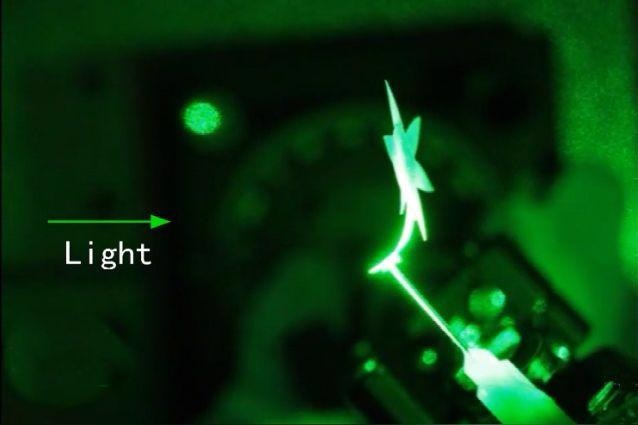Mar 15 2021
New light-activated composite devices developed by scientists from Tufts University School of Engineering exhibit the ability to perform accurate, visible movements and develop complicated three-dimensional shapes without requiring wires, energy sources, or other actuating materials.
 A photonic sunflower moves and tracks a source of light, maximizing exposure. Image Credit: Tufts University.
A photonic sunflower moves and tracks a source of light, maximizing exposure. Image Credit: Tufts University.
The design of the device integrates programmable photonic crystals with an elastomeric composite that can be engineered at the nano- and macro-scale to respond to light.
The study offers new ways for developing smart light-driven systems such as high-efficiency, self-aligning solar cells that automatically follow the direction of the sun and angle of light, light-actuated microfluidic valves or soft robots that move with light on demand.
A “photonic sunflower” with petals that become curled toward and away from light and which tracks the angle and path of the light illustrates the technology in a paper that was published in the Nature Communications journal on March 12, 2021.
Color is the product of the absorption and reflection of light. Every flash of an iridescent butterfly wing or opal gemstone involves the intricate interactions in which natural photonic crystals embedded in the stone or wing absorb light of particular frequencies and reflect others. The angle at which the light coincides with the crystalline surface can impact which wavelengths are absorbed and the heat produced from that absorbed energy.
The photonic material developed by the Tufts researchers combines two layers: an opal-like film formed of silk fibroin doped with gold nanoparticles (AuNPs), developing photonic crystals, and a basic substrate of polydimethylsiloxane (PDMS), which is a silicon-based polymer.
Besides notable durability, flexibility, and optical properties, silk fibroin is exceptional in that it has a negative coefficient of thermal expansion (CTE), implying that it shrinks upon heating and expands upon cooling. By contrast, PDMS has a high CTE and expands quickly upon heating.
Consequently, upon exposure of the innovative material to light, one layer gets heated up much more quickly compared to the other, so the material tends to bend as one side gets expanded and the other expands or contracts more gradually.
With our approach, we can pattern these opal-like films at multiple scales to design the way they absorb and reflect light. When the light moves and the quantity of energy that’s absorbed changes, the material folds and moves differently as a function of its relative position to that light.
Fiorenzo Omenetto, Study Corresponding Author and Frank C. Doble Professor of Engineering, Tufts University
In general, a majority of the optomechanical devices that transform light to movement necessitate complex and energy-intensive setups or fabrication.
We are able to achieve exquisite control of light-energy conversion and generate ‘macro motion’ of these materials without the need for any electricity or wires.
Fiorenzo Omenetto, Study Corresponding Author and Frank C. Doble Professor of Engineering, Tufts University
The photonic crystal films were programmed by the team by using stencils and further exposing them to water vapor to produce particular patterns. The surface water pattern modified the wavelength of reflected and absorbed light from the film, thereby making the material bend, fold, and twist in several ways, based on the geometry of the pattern, upon exposure to laser light.
As part of the study, the researchers demonstrated a “photonic sunflower” with combined solar cells in the bilayer film so that the cells were able to track the light source. The photonic sunflower maintained the angle between the solar cells and the laser beam almost constant, thereby optimizing the efficiency of the cells as the light moved.
Moreover, the system can function well with white light as it does with laser light. These light-responsive, heliotropic (sun-following), wireless systems could possibly improve light-to-energy conversion efficiency for the solar power industry.
Also, the researchers’ demonstration of the material consisted of a butterfly, the wings of which opened and closed as a reaction to light and a self-folding box.
The study extends current studies by Omenetto and collaborators at Tufts School of Engineering dealing with the use of silk as a sophisticated material platform in nanotechnology, electronics, and photonics.
Light tracking solar cell
A solar cell mounted on the light actuated material can move and track a light source without wires, gears, or motors. Video Credit: Fio Omenetto, Tufts University.
Journal Reference:
Wang, Y., et al. ( 2021) Light-activated shape morphing and light-tracking materials using biopolymer-based programmable photonic nanostructures. Nature Communications. doi.org/10.1038/s41467-021-21764-6.